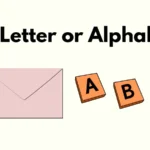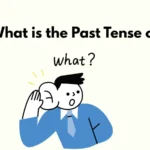In classrooms, conversations, and even in casual writing, many people mix up the words “letter” and “alphabet.” It seems small, but this confusion can lead to bigger problems, especially for students, teachers, and learners of all ages.
If you’re someone who wants to write, read, or teach better English, understanding the real difference between a letter and an alphabet is a must.
This article will clear up the confusion with straightforward definitions, examples, interesting facts, and practical insights. You’ll see why these terms aren’t interchangeable and why knowing the difference actually matters.
Why Do People Mix Up Letter and Alphabet?
You might have heard people say things like “learn your alphabets” when they actually mean “learn your letters.” This happens a lot because in everyday talk, these words seem similar. Kids sing the “Alphabet Song” but learn individual letters one by one.
The problem is that while letters and alphabets are connected, they don’t mean the same thing. Mixing them up can make it harder to understand reading, spelling, and even some teaching methods.
What Exactly Is a Letter?
A letter is a single written symbol that stands for a sound or sounds in a language. Letters are the smallest pieces that make up words.
For example, the letter A can sound like the “a” in apple, and the letter B stands for the “b” sound in ball. Each letter helps form words when combined in different ways.
Some quick facts about letters:
- The English language uses 26 letters.
- These letters are split into two groups: vowels (A, E, I, O, U) and consonants (the rest).
- Letters come in uppercase (capital letters) and lowercase (small letters), like A and a.
What Is an Alphabet?
An alphabet is a complete set of letters that a language uses for writing. You can think of it like a toolbox filled with all the letters you need to write any word in that language.
For English, the alphabet includes all 26 letters from A to Z. When someone says “I know the alphabet,” it means they know the entire set of letters.
Letter vs Alphabet: How Are They Different?
Here’s a simple way to remember:
| Feature | Letter | Alphabet |
| What it is | One single character | The whole set of letters |
| How many | One at a time | 26 in English |
| What it does | Represents a sound | Provides the system for writing |
| Example | “A”, “B”, “C” | “A to Z” (all letters together) |
| Common mistake | Saying “learn the alphabets” instead of “letters” | Saying “I sent an alphabet” instead of “a letter” |
Think of it this way: A letter is like a brick, while the alphabet is the whole wall made from bricks.
The History Behind the Words
Understanding where these words come from helps make their meanings clearer.
- The word “letter” comes from Latin littera, which means a written character.
- “Alphabet” comes from the first two letters of the Greek alphabet, alpha and beta. This word means the entire sequence of letters in a language.
The Greek alphabet is one of the oldest, dating back about 2,800 years.
How Letters and Alphabets Work Together
You can’t write or spell without letters. And you can’t have letters outside of an alphabet, because the alphabet is the full system of letters.
Here’s a helpful comparison: Letters are your ingredients, and the alphabet is your pantry stocked with all those ingredients. To make any recipe (a word or sentence), you need the full pantry (alphabet) to access all the ingredients (letters).
Real-Life Examples of Confusion
In Classrooms
Teachers often say, “Let’s learn the alphabet,” but what they really mean is “Let’s learn these letters today.” Young students sometimes think each letter is a separate alphabet.
For Language Learners
English learners sometimes say things like, “I know 10 alphabets,” when they mean “I know 10 letters.” This makes it tricky to follow lessons on spelling or pronunciation.
In Everyday Speech
You might hear someone say, “I sent him an alphabet,” when they meant “I sent him a letter.” This confusion can lead to misunderstandings.
Different Alphabets Around the World
Not all languages use the same alphabet as English. Here are some examples:
| Language | Alphabet Type | Number of Letters |
| English | Latin alphabet | 26 |
| Russian | Cyrillic alphabet | 33 |
| Arabic | Arabic alphabet | 28 |
| Greek | Greek alphabet | 24 |
| Hawaiian | Latin alphabet | 13 |
Knowing different alphabets helps when you learn new languages or teach students from various backgrounds.
Why Knowing the Difference Matters
Understanding the distinction between letters and alphabets matters because:
- It helps with spelling and pronunciation.
- It supports clear communication in teaching and writing.
- It prevents confusion in language learning, especially for ESL students.
- It’s essential for people working in technology, typography, and design.
Case Studies: Letters vs Alphabet in Real Life
Case Study 1: A Teacher’s Experience
Ms. Johnson, a 3rd-grade teacher, explains how she teaches letters separately before introducing the alphabet as a whole. She noticed students grasp reading better when they understood that letters are individual sounds but the alphabet is the complete system.
Case Study 2: ESL Learner Mix-Up
Ahmed, an English learner, kept saying “alphabets” when he meant letters. His teacher corrected him gently, which helped Ahmed improve his vocabulary and confidence in using English correctly.
Case Study 3: In Technology
Font designers rely heavily on the difference because fonts include all letters of an alphabet. Mistaking a letter for an alphabet could cause problems in software design or printing.
Frequently Asked Questions
Is “Z” a letter or an alphabet?
Z is a letter. The alphabet includes all letters from A to Z.
Can an alphabet have just one letter?
No. An alphabet is by definition a set of letters, so it must include more than one.
Are all letters part of an alphabet?
Most letters are, but some symbols like “@” or “&” are not letters and don’t belong to the alphabet.
What is the smallest known alphabet?
The Rotokas language spoken in Papua New Guinea has an alphabet with only 12 letters.
Do emojis count as letters?
No. Emojis are symbols but don’t represent sounds like letters do.
Final Thoughts: Remember This
Letters are parts, the alphabet is the whole. That simple idea unlocks a better understanding of how language works. When you know the difference, reading, writing, teaching, and learning become clearer and more effective.
Visual Summary: Alphabet vs Letter
Imagine the alphabet as a box holding all letters:
- Alphabet = the box
- Letters = the pieces inside the box
Without letters, you can’t write words. Without an alphabet, letters don’t form a system.
Bonus: Fun Ways to Teach Letters and the Alphabet
- Letter scavenger hunts: Find objects that start with each letter.
- Alphabet songs: Great for memorizing the whole set.
- Flashcards: Separate cards for letters and whole alphabet charts.
- Apps: Many apps let kids practice letters individually and then combine them into words.

Mia Rose is the grammar enthusiast and content creator behind GrammerHome.com, where she brings clarity to the often-confusing world of English grammar. With a strong background in language education and a passion for helping others, Mia’s writing style blends simplicity, depth, and a touch of charm.




